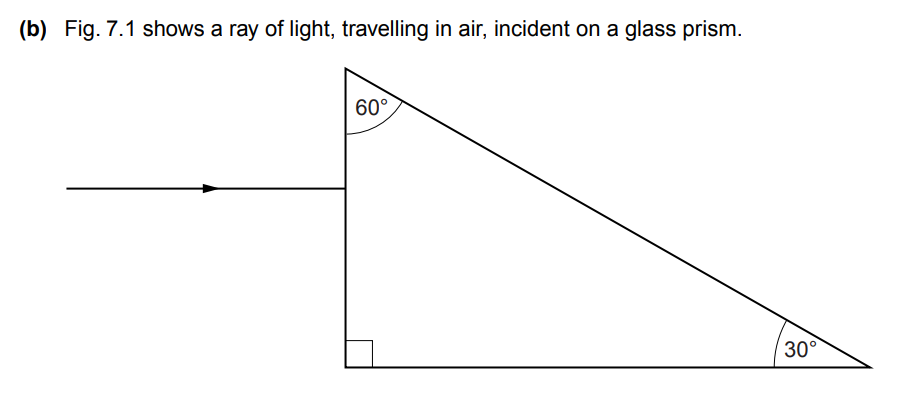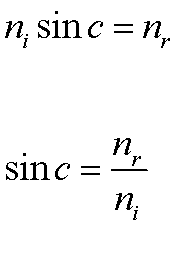Physics > Waves > A different approach for IGCSE refraction
My approach consists of reducing the quantity of memorization by the use of higher level thinking skills, like deduction.
There aren´t very many formulas and facts to memorize in this topic, but the less you have to rely on memorization the better because by the time you take your GCSE´s there will be dozens of formulas to be memorized, in physics only.
I propose to memorize one formula (which is not in the syllabus) instead of 2 formulas and 2 facts, which are on the syllabus.
The memorization
The formulas on the Cambridge IGCSE triple science syllabus (0625) , regarding refraction, are:
(I) Snell´s law (limited version : only works if light is coming from air or vacuum)

(II) Critical angle c (limited version : it assumes the refracted medium is air or vacuum)

In both formulas above n is the refractive index, defined as the ratio of the speed of light in the vacuum and the speed of the light in the medium. The angles i and r are the incident and refracted angles respectively and c is the critical angle. All this terminology is explained in my refraction page.

image from Wikipedia, where the subscrits 1 and 2 are used here instead of i and r.
It is also needed to memorize the fact (III) that light bends away from the normal when moving into a medium that has lower refracting index than the previous, like moving from glass to air or from water to air, for example. This is not mentioned explicitly in the syllabus but you are expected to know it. Below I show an IGCSE physics question that requires that piece of knowledge:


Image from IGCSE past paper
This was a question where you should calculate the refracted angles from air to glass but when it comes to refraction from glass to air you don´t calculate, you just drawn. The thing is that to draw it properly you need to know that it will bend away from the normal.
The problem is that this information needs to be memorized separately because the Snell´s Law you are supposed to use is limited.
Finally you have to memorize the fact (VI) that light can only undergo total internal reflection if it comes from a medium with a higher refractive index (more details below).
My proposal
My proposal is to learn the "full" Snell´s law and deduct the rest you need to know from it. It is not a complicated formula anyway. This way you will have a better understanding of what is happening and will be able to use a variety of physics books other than GCSE) and also websites like hyperphysics.
You may say: why will I learn a formula that is not in the syllabus? Answer: because it will make your life easier, if you are willing to do some extra thinking. So, yes, this is optional.
The "full" Snell´s Law is the only formula to be memorized (IV):

The subscripts i and r stand for incident and refracted light respectively.
That is the one to be memorize. It is not hard, is it?
Deduction formula (I) from (IV):
Formula (I) applies only when light comes from a medium with n = 1, so it can be obtained replacing ni by 1 in formula (IV).
Deduction formula (II) from (IV):
Formula (II) gives the critical angle c, which is the angle above which total internal reflection (TIR) occurs. When we say critical angle we mean the critical incident angle.
As the angle i is increased the angle r increases correspondingly until it reaches the limit of 90 degrees. Beyond that we have TIR. In other words, the critical incident angle occurs when the refracted angle is 90 degrees.
This fact can be visualised using the PHET animation of refraction.
If we plug 90 degrees for the refracted angle in formula (IV) we get sin 90 = 1. We also substitute θi by c (to keep the IGCSE terminology), so we get equation (V):

Notice that the last formula equals formula (II) in the case where nr =1, e.g., when the refracted medium is air or vacuum.
So, yes, formula (II) only works in this specific situation, although some books don´t make that very clear. It won´t work in the case of an optical fibre, where TIR happens due to a difference in refractive indexes between 2 types of glass (and not between glass and air).
It can also be deducted from formula (V) that TIR can only occur when ni > nr , which is fact (VI). This condition is necessary because the sine of an angle cannot be higher than 1.
Finally, we can deduce fact (III) from equation (IV)

If ni > nr then θi < θr
Where can we deduct the "full" Snell´s law from?
Check out my page on the Principle of least time
